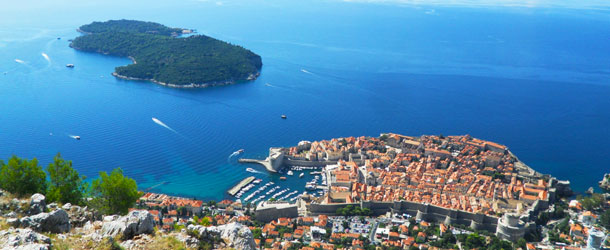When it comes to Mediterranean and European cruises, you’re certainly spoiled for choice when it comes to itineraries, but there’s one city which you simply shouldn’t miss if your cruise takes you along the shores of the Adriatic. Dubrovnik offers one of the most enthralling old town centres you’re ever likely to explore and with areas of stunning natural beauty to experience too, it’s easy to see why it’s become one of the Mediterranean’s most-visited tourist destinations.
It’s not entirely clear when the area on which Dubrovnik now stands was first settled, though ruins of an ancient basilica excavated recently show its origins date back to at least the 8th century. Throughout its long history, the city has been in the hands of the Byzantine and Habsburg Empires and has been strongly influenced by both the Republic of Venice and the Ottoman Empire. The city itself has endured a number of catastrophes throughout history, including a devastating 1667 earthquake, an extended siege by the Napoleonic army and most recently, the siege of Dubrovnik, when in 1991, the Yugoslav People’s Army and the Croatian forces defending the city clashed during the Croatian War of Independence. Today, the damage the Old Town sustained during the siege has been repaired and it has been faithfully restored to its former glory.
Culture
Dubrovnik’s Old Town and its surrounding walls are the main reason why so many people visit the city. The ancient city walls are one of Dubrovnik’s biggest attractions and are a great way to explore the city from above as well as get a feel for its ancient architecture. Along the route, there are forts and towers to scale as well as some superb views of the city and the Adriatic Sea to be had. Handily, there’s a bar tucked away within one of the walls, which offers much-needed refreshments during your walk. Though it’s virtually impossible to avoid the tourist crowds, your exploration of the Old Town will be a little more relaxed thanks to the fact that it is completely pedestrianized. It’s completely enclosed, so even if you fancy a wander through the back streets, you won’t get lost and it won’t be too hard to find your way back toStradun, the gated main thoroughfare. Another popular way to see the city from above is by taking a cable car to the top of Mount Srdj, which is the best way to visit another of Dubrovnik’s most popular attractions, the Museum of the Croatian War of Independence, which offers an educational insight into the conflict.
Nature
When it comes to natural attractions outside Dubrovnik itself, the surrounding islands offer a number of possibilities. Mjet is often referred to as Croatia’s greenest island and indeed, in its north-western area, you’ll find a National Park which offers wilderness escapes, lakes and two picturesque beaches which prove very popular with sun-seekers. Lokrum is a short boat ride from Dubrovnik and is a great place to go if you want to get away from the crowds. It offers nature-lovers the chance to explore its beautiful botanic garden and 300-year old olive grove and there are plenty of well-shaded places to get out of the sun. The island is also very popular with swimmers and offers a number of prime spots. Another island which is perfect for getting away from it all is Lopud, where there’s no traffic a laid-back atmosphere and the perfect sandy escape in the form of Sunj Beach.
Shopping
The main thoroughfare Stradun is the place to go if you want to pick up a souvenir or two and there are all manner of shops offering examples of the local crafts, including ceramics, local delicacies, traditional sweets, jewellery and wine. Interestingly, art is quite a big deal in Dubrovnik and the city’s independent art galleries are also some of its most popular shops and exhibit and sell large numbers of works from local artists and graphic designers, including oil and canvas paintings as well as photographic pieces. Some of the shops are specifically themed and decorated to reflect Dubrovnik’s ancient heritage and well worth a visit, even you don’t have a lot of cash to spare.
By Simon Brotherton
Google


Comments: no replies